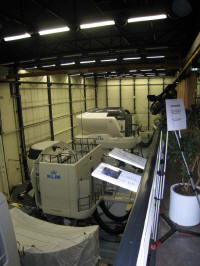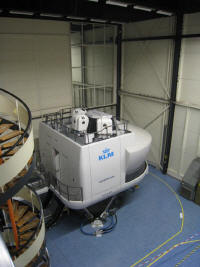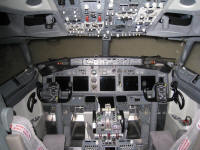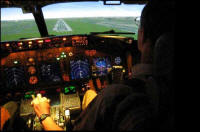


Flight simulator training facility, with Airbus and Boeing simulators. One
simulator still in construction phase.


Simulator in action: The left picture shows the tilt of the sim when
braking. A huge hexapod motion system.
Visuals: The cockpit in the simulator is identical to the real thing. The outside view in the Boeing 737 sim is curved screen, at about 2~3 meter distance, spanning 115 degrees. Airbus simulators have 180 degrees I'm told. As far as I could tell, the scenery looks seamless. It is CRT generated, so sometimes the scan lines are visible. Front and side views move very realistic. There is a slight view offset between left seat / right seat, but quite good actually. Must be something smart in the visual system. Sometimes there is a discussion about this offset when making centerline accuracy landings. Scenery resolution is pretty good, maybe slightly lower than MSFS. Scenery detail is less than MSFS (no trees or autogen objects, but functional. Especially low visibility view (CAT I / II / III) is very accurate.
Instructor panel:
The simulator is setup with an instructor panel behind the pilots. The
instructor can run all kinds of situations, and talks back the other end of
the radio communications. Before the simulator session, there is a 2 hour
briefing where all kinds of system related issues are discussed and
explained. During the 3 hour simulator training session, a lot of emergency
situations are setup, off course without the pilots knowing what's
coming up. Variations in weather can be added, and pretty worst-case
scenario's are chosen. The simulator can be paused, or run at faster speed.
When loading a certain situation, the control panel will show which controls
are not in accordance with the new situation (gear, flaps). Also the CDU
often needs to be reprogrammed with correct weight, and autopilot values
need to be set.
Controls:
The control yoke feels pretty heavy, with lots of friction / damping.
The aileron has a clear center detent, especially during flight. The control
force of the elevator is not extreme, but clearly noticeable during flight.
Trimming for zero elevator force was a bit trickier than I thought as the
center zone is not so clear. The trim switches are sturdy types. The trim
wheels spin with a lot of noise. Rudder pedals require a lot more force to
move, both in standstill as in flying condition. The rudders are quite
responsive during flight: Immediate lateral motion and visuals when moving
them a little during cruise. Aileron was also quite responsive, elevator a
bit less.
The brakes are extremely heavy. It really takes a lot of force to activate
them, estimated 30~40kgf or so. (or maybe I was doing something wrong?
The throttle is not so heavy. It slides like you would expect of a
construction of that sort. The auto throttle is cool at take-off, smooth
without any noise or vibration. The reverse braking levers took considerable
force. Maybe I did it wrong, but I thought it required a bit too much force.
I did not get to move the gear or flaps.
Flying:
We had a few minutes to spare, so the instructor let me make a take-off,
cruise and landing, very exiting! It took a bit of effort to get seated and
strapped in. I was surprised at the confined space of a pilot seat. You are
really closed in by the front, pedestal and side with manuals. Also much
closer to the glare shield and windows than I would have thought.
I normally do not fly heavies, but I did some practice on the FS default 737
the days before. The conditions were good, so takeoff was no real issue. It
took some fiddling to understand the auto-throttle activation knobs. Rudder
responded very good. The lateral motion feedback is really accurate in this
respect. Rotate and climb went well. We made a quick pattern (double speed
to save time) and set up for final. I found that flying with autothrottle
easily gets you in an oscillation mode, where you try to correct pitch
continuously. Switching to manual throttle made it much easier.
Following the flight director cross and glideslope bug was pretty much like
in FS. I did overshoot the touchdown zone a bit, and did not pull the yoke
enough during flare, but overall the landing was not so bad. Reversing took
some effort, as did the braking. Note that I did get some help from my
friend concerning throttle and flare. A really great experience!
A short video from the training session can be seen here.

